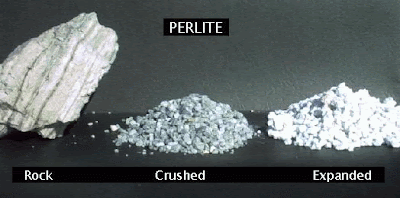The formula for cristobalite is SiO2. Here's where it can get a little confusing. I mentioned in yesterday's post that obsidian was made of silica or SiO2. But it's in the form of amorphous glass which means the silicon and oxygen atoms aren't arranged in a regular repeating (crystalline) lattice throughout the rock because it cooled too quickly for the atoms to arrange that way.
A piece of obsidian I have laying around - SiO2 glass
SiO2 is also the formula for the common mineral quartz. In this case, the silicon and oxygen atoms are arranged in a regular repeating fashion forming a crystalline structure (not necessarily a nice quartz crystal, even a lumpy irregular mass of quartz has a crystalline structure).
Crystalline quartz (SiO2) even though they're not crystals
Cristobalite is also SiO2. In this case it is also a mineral, like quartz, but with a different crystalline structure because it's stable at higher temperatures (above 1,470° C) but can exist in a metastable state at Earth surface temperatures and pressures. We call minerals, like quartz and cristobalite, that have the same chemical formula but different crystalline structures, polymorphs. The mineralogy of cristobalite is complicated (read about it here) so I'm not going to even attempt more of an explanation here (by the way, there are also other polymorphs of SiO2 besides quartz and cristobalite).
Anyway, when cristobalite forms in obsidian due to devitrification, it typically forms white splotchy masses scattered through the rock that look like snowflakes - hence the name snowflake obsidian.
Cristobalite in snowflake obsidian
Snowflake obsidian is quite attractive when polished and you can find examples of worked snowflake obsidian at any rock and mineral show.
Examples of snowflake obsidian carvings
 As obsidian keeps hydrating and devitrifying, over hundreds of thousands to millions of years of exposure on the Earth's surface, it eventually decomposes into perlite. Many of you have probably heard of perlite since it's often mixed with soil to improve hydration and aeration.
As obsidian keeps hydrating and devitrifying, over hundreds of thousands to millions of years of exposure on the Earth's surface, it eventually decomposes into perlite. Many of you have probably heard of perlite since it's often mixed with soil to improve hydration and aeration.Perlite is also amorphous volcanic glass, like obsidian, but hydrated with a lot of water. When you heat raw perlite to 850–900 °C, it softens (because it's glass) and the trapped water vaporizes and escapes expanding the material by over 10 times its original volume resulting in low density, pH-neutral, bright white "rock" which is then ground into various sizes for different uses.
Perlite is not only used as a soil additive, it also has tons of other industrial uses as a filler, insulator, aggregate, and abrasive.
For some reason, I have a whole bowl-full of Apache tears at my house and I have no memory of where I got them (other than I did not collect them and probably bought them at a rock show). Here is a sampling.
According to Wikipedia: "The name "Apache tear" comes from a legend of the Apache tribe: about 75 Apaches and the US Cavalry fought
on a mountain overlooking what is now Superior, Arizona in the 1870s. Facing
defeat, the outnumbered Apache warriors rode their horses off the mountain to
their deaths rather than be killed. The wives and families of the warriors cried
when they heard of the tragedy; their tears turned into stone upon hitting the
ground."
Apache Leap Mountain, Superior, AZ
The "legend" part is the formation of the obsidian. In the winter of 1870, Company B of the Arizona Volunteers did apparently corner a band of Apaches on top of Big Picacho (Apache Leap Mountain) resulting in a number of them leaping to their deaths rather than die at the hands of the U.S. cavalry.
Science and culture (yes, Johnny Cash is culture).











Love your blog.
ReplyDeleteI've found Obsidian around my house in Warwick, New York. Is this unusual? Or pretty much in the Hudson Valley Scheme of things.
Ravishing regards,
E. Jean Carroll
Thanks (never had anyone sign "ravishing regards" before!).
DeleteThere's no native obsidian in NY. Could it have been dumped there? Alternatively, there is chert in many NY limestones. Chert is often black, shiny, and glassy like obsidian.
A great post. I was looking for information on what happens to mahogany obsidian when it starts to devitrify - I've never seen snowflake mahogany obsidian.
ReplyDeleteI found a good sized hunk near St Andrews Church on Staten Island.
ReplyDelete